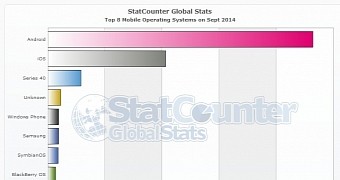Windows Phone is Microsoft’s big bet in the mobile world, but as things stand right now, adoption isn’t going very well for the Redmond-based software giant.
Market share figures provided by researcher StatCounter indicate that Windows Phone is not only way behind rivals Android and iOS, but also very close to old operating systems such as Symbian.
While this is a bit embarrassing given the fact that Microsoft has been pouring millions of dollars in Windows Phone development and marketing, it’s also a sign that, at least globally, the operating system is suffering from slow adoption in a market dominated by Android and iOS.
Windows Phone, however, performs a little bit better in emerging markets such as India, where Microsoft’s cheap devices are actually truly powerful rivals for Android.
Android still the king
StatCounter data shows that Android remains the undisputed leader in the mobile OS market with a share of 55.7 percent, while Apple’s very own iOS comes second with 24.73 percent.
Unfortunately for Microsoft, Windows Phone is far behind with only 2.29 percent, which brings it very close to Symbian OS, which at this point is said to be installed on 2.18 percent of the devices connected to the Internet.
Microsoft cannot be satisfied with such numbers, at least not when it’s pretty clear that expectations are very high, but the company is well positioned to make Windows Phone more successful in the long term.
Rebranding prepared for early 2015
Sources close to the matter indicate that Microsoft is planning a rebranding strategy for Windows Phone that could actually bring more customers on board faster than predicted.
It appears that Microsoft is planning to rebrand Windows Phone as just Windows and thus capitalize on the popularity of its desktop operating system, in a move that’s clearly supposed to attract the attention of buyers who are looking for new phones.
Of course, this could also cause more confusion mostly because consumers buying Windows smartphones might actually expect to see the full desktop OS functionality on their new devices, so it’s in the end a double-edged sword.
The new strategy should come into effect in early 2015, sources say, when Microsoft could also merge Windows RT and Windows Phone into a single operating system powering both tablets and smartphones. A lot of vague details are, however, available right now, so we still have to wait a few more months to find out what’s to come for Windows Phone.

 14 DAY TRIAL //
14 DAY TRIAL //